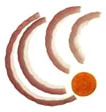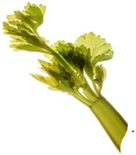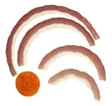| FAST! EASY! AND FRESH! NUTRITIOUS GOOD IDEA |

By The American Dietetic Association’s Complete Food & Nutrition Guide
Whether it’s the main attraction or an accompaniment to a simple
entrée, it’s hard to come up with a dish that is better suited to summer
dining.
Salads can help you take advantage of the summer boon of fresh
vegetables and fruits. Salad is also an easy way to combine leftovers into
a tasty meal for one or two. Most or all preparation can be done early in
the day, when temperatures are lower and you have more energy.
Many supermarkets also sell pre-prepared greens and vegetables or have a
salad bar that will allow you to create a salad in minutes. And of course,
salads offer a convenient way to add produce to your meals.
Fruits and veggies may not look dirty, but all produce should be cleaned
before serving. So Lets' start with a safety precaution:Washing!
Wash-Wash and Wash Washing veggies and fruits is easy!
1• Fill a sink with fresh (hopefully filtered) water.
2• Remove and discard the outer leaves of leafy veggies.
3• Soak the veggies and fruits for several minutes.
4• Scrub them with a brush if necessary, particularly if outer skins are to be eaten raw.
5• Rinse them in water.
Salad bowl basics
Salads can be composed of virtually any combination of ingredients that seem appealing. For a main dish salad start with a sturdy base. Try cooked grains like pasta, rice, couscous or barley, cubed or sliced cooked potato, or legumes like white or black beans or chickpeas. Add a variety of raw or cooked vegetables cut into bite-sized pieces. If you are using cooked vegetables, those that have been minimally cooked provide the best texture. Also include a source of protein such as cooked meat or poultry, some canned tuna fish, chopped hard-boiled egg, nuts, or legumes. Serve your choices on a bed of leafy greens; deeply colored varieties like romaine lettuce, arugula, or fresh spinach contain more nutrients than lighter varieties.
Salads also lend themselves naturally to the technique of making two meals from the same ingredients. For example, cook chicken breast, couscous or rice, and steamed green beans one night; a day or two later toss the leftovers with chopped sweet onion, tomato, and fresh spinach and a dressing of olive oil and red wine vinegar.
Dressing for success
The main dietary caveat for salads lies in the dressing, which is usually the most significant source of fat and calories. If you are buying a dressing or choosing one from a restaurant or salad bar, and want to cut back on your fat, look for reduced- or low-fat varieties, or mix equal amounts of regular and low-fat dressing. Portion size counts as well. A single ladle of dressing at an American salad bar typically holds 2-3 tablespoons of dressing; half that amount is usually sufficient to dress even a large salad. If the salad bar is not self-service, ask your server to provide the dressing on the side.
When preparing creamy dressings at home, substitute plain low-fat yogurt or buttermilk for all or part of the mayonnaise. For oil and vinegar dressings lean to heart-healthy canola (rapeseed) oil and olive oil in a ratio of one part oil to two parts vinegar. Using flavorful vinegar like balsamic or sherry vinegar, or substituting fresh lemon or lime juice for some of the vinegar will help compensate for using less oil. So will adding chopped fresh herbs to your salad and minced garlic and/or Dijon mustard to salad dressings.
Commercially prepared salads are convenient but can be quite high in fat due to items like mayonnaise, cheeses, and deli meats. You can decrease the overall fat content by starting with a smaller portion and adding your own plain ingredients. Try adding steamed green beans to potato salad, grated carrot or fresh peas to cole slaw, or diced fresh tomato or sliced cooked beets to macaroni salad. For a main dish meal, mix half a cup of commercially prepared tuna or seafood salad with a cup of chopped fresh vegetables from a salad bar.
Salad days are here!
Make the most of them now because it won’t be long before
the flavor of a ripe fresh tomato is only a summer memory.
![]()
CONTAC
INFO: TEL.619-427-4111 EMAIL: health@infooption.com
|
Salud + Health Info is for information and educational purposes only. You should not rely on this information as a substitute for personal medical attention, diagnosis or hands-on treatment. If you are concerned abut your health or that of a child, please consult your family’s physician or health provider immediately and do not try to diagnose yourself.
Copyright © 2001-2006 Info Option Network
 info
info

